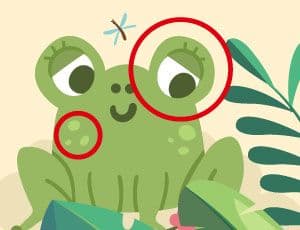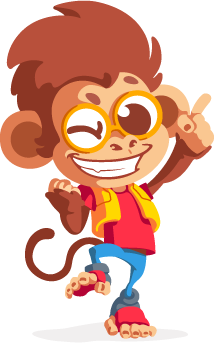Escola Games | Jogos Educativos
https://www.escolagames.com.br
Teacher's support sheet

Spot the differences
Hello! How about carefully examining the images and discovering the 5 differences between the two drawings presented in the online game? Pay attention to the red bar, as it indicates how much time you have to analyze each drawing. When you find the 5 differences, use the red arrows to select a distinct drawing. Follow the instructions closely to advance in the game and complete it successfully. Frogs, aliens, toy soldiers, little clowns, magicians, knights, in short, these will be some of the SUPER COOL characters you'll deal with and be enchanted by in this game. Go ahead and play now, have fun, child, exercise your memory and motor coordination. Click to mark a "difference" and good luck!

Teacher's tips
“Spot the differences" games are essential for a child's psychological and motor development since they contribute to body, affective, and cognitive formation. It develops imagination, motor coordination, concentration, and cooperation, besides promoting self-esteem, so it is important to adhere to this tool to stimulate the learning process. Through games and play, children explore the environment in which they live and learn more about the objects of human culture, internalizing rules and social roles. Many schools are expanding the use of technologies to offer their students interactive means that enrich their skills and abilities. Digital games develop visual concentration and are a didactic resource that can benefit students and teachers of all disciplines. Therefore, in this game, children will playfully learn Mathematics! [FIM-DICA]
Learner outcomes
To spot the differences between two figures that are equal at first sight; To realize that Mathematics can be much more pleasurable with playful activities; To exercise memory, visual perception, and motor coordination through playful activities; To solve conflicts in interactions and games with the guidance and intermediation of an adult.
Teachers’ goals
To develop children's logical reasoning through the visual perception implicit in the game; To improve the rationalization (logic) of children in Mathematics classes; To stimulate creativity and deductive reasoning; To assist in organizing information and developing the ability to formalize problems; To provide an environment of free imagination and creativity.
Suggestions of approaches for the teacher
We all share similarities and differences! How about a dynamic for children to get in the mood for the game? It is necessary to understand that people are not the same, which creates a perception of identity and respect for differences. Develop a group activity for students to get to know each other better. Students will understand about diversity and respect for differences. They will realize that we share similarities, and we also must respect the differences. Our virtues add up with those of others, and we evolve together. Self-knowledge, social awareness, identification with the group, empathy, solidarity, and respect will be some themes implicit in this dynamic.
How to proceed with the dynamics? Hand students a quiz with the following questions:
- Describe yourself and your greatest strengths and weaknesses.
- What do you intend to be when you become an adult? What profession do you plan to practice and why?
- What animals do you like best? What is your favorite food?
- In your opinion, is it important to do things to improve the world?
- People are so different. Don’t you think that’s important? Why?
- In your opinion, is it possible to get along with people and respect their differences?
After giving each child time to complete the quiz, go to the board and draw a diagram with two circles joined by an intersection. Invite two students to go to the board and exchange their quizzes. Ask the class to compare the answers after reading each one. When the answer is the same, it should be mentioned only once at the intersection between the two circles that is, write only the similarities. Guide students at this moment, showing them the similarities and differences revealed. Afterward, discuss with the children some attitudes and patterns you have observed in the class. This is the ideal time to talk about good coexistence and respect for differences.
Another very interesting activity is the "Self-portrait." Ask children to make a drawing representing them, recording their physical characteristics and punctuating their virtues and values. Then put the drawings on a mural.
More about the content
Simple activities, such as differentiating two similar images, activate several brain areas. Although the game seems so simple, the child assimilates several implicit contents. It would be good to prepare a concrete activity to take better advantage of the context of the game. You can ask students to spot the differences between printed figures. You can also prepare cards with coloring activities and identify the five differences. Children will love it!
The PE teacher can take students to the court or courtyard and suggest that they organize themselves in a circle. Then ask them to look at each other, paying close attention to the characteristics of the others: hair color, eyes, skin, height, accessories (glasses, earrings, watches, clothes), and others. Then, propose the following game: At first, one child at a time should choose a colleague to throw the ball, saying a similar characteristic between them (For example, I throw the ball to Samuel, as we both wear watches and shorts). However, he cannot repeat the characteristic, neither can the colleague. At this moment, students will exercise memory and develop the capacity for attention and concentration. They will reinforce the flexibility of thought - in the sense of having to give up the colleague or the previously chosen characteristic and consider other possibilities. Once everyone has played and received the ball, start the 2nd round. Each child must hand the ball to the colleague who chose them in the 1st round, revealing a different characteristic between them. Again, the characteristic cannot be repeated (e.g.: Julia returns the ball to her colleague since he is short and she is tall). And so on, until everyone returns the ball to the colleagues who chose them in the 1st round. This game will make everyone realize how different we are, which is very positive because we learn from others and we need to value ourselves as we are unique.
